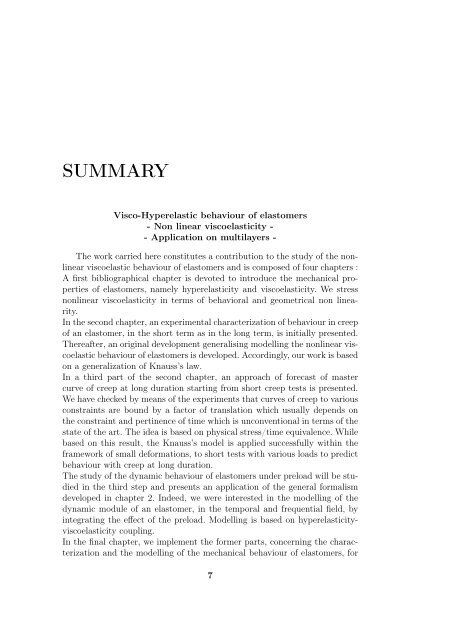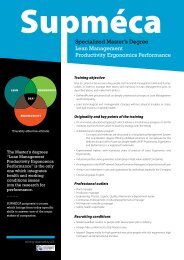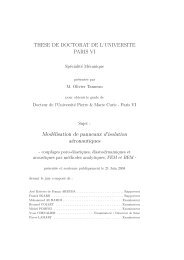THESE DE DOCTORAT DE L'UNIVERSITE PARIS VI - LISMMA
THESE DE DOCTORAT DE L'UNIVERSITE PARIS VI - LISMMA
THESE DE DOCTORAT DE L'UNIVERSITE PARIS VI - LISMMA
You also want an ePaper? Increase the reach of your titles
YUMPU automatically turns print PDFs into web optimized ePapers that Google loves.
SUMMARYVisco-Hyperelastic behaviour of elastomers- Non linear viscoelasticity -- Application on multilayers -The work carried here constitutes a contribution to the study of the nonlinearviscoelastic behaviour of elastomers and is composed of four chapters :A first bibliographical chapter is devoted to introduce the mechanical propertiesof elastomers, namely hyperelasticity and viscoelasticity. We stressnonlinear viscoelasticity in terms of behavioral and geometrical non linearity.In the second chapter, an experimental characterization of behaviour in creepof an elastomer, in the short term as in the long term, is initially presented.Thereafter, an original development generalising modelling the nonlinear viscoelasticbehaviour of elastomers is developed. Accordingly, our work is basedon a generalization of Knauss’s law.In a third part of the second chapter, an approach of forecast of mastercurve of creep at long duration starting from short creep tests is presented.We have checked by means of the experiments that curves of creep to variousconstraints are bound by a factor of translation which usually depends onthe constraint and pertinence of time which is unconventional in terms of thestate of the art. The idea is based on physical stress/time equivalence. Whilebased on this result, the Knauss’s model is applied successfully within theframework of small deformations, to short tests with various loads to predictbehaviour with creep at long duration.The study of the dynamic behaviour of elastomers under preload will be studiedin the third step and presents an application of the general formalismdeveloped in chapter 2. Indeed, we were interested in the modelling of thedynamic module of an elastomer, in the temporal and frequential field, byintegrating the effect of the preload. Modelling is based on hyperelasticityviscoelasticitycoupling.In the final chapter, we implement the former parts, concerning the characterizationand the modelling of the mechanical behaviour of elastomers, for7








